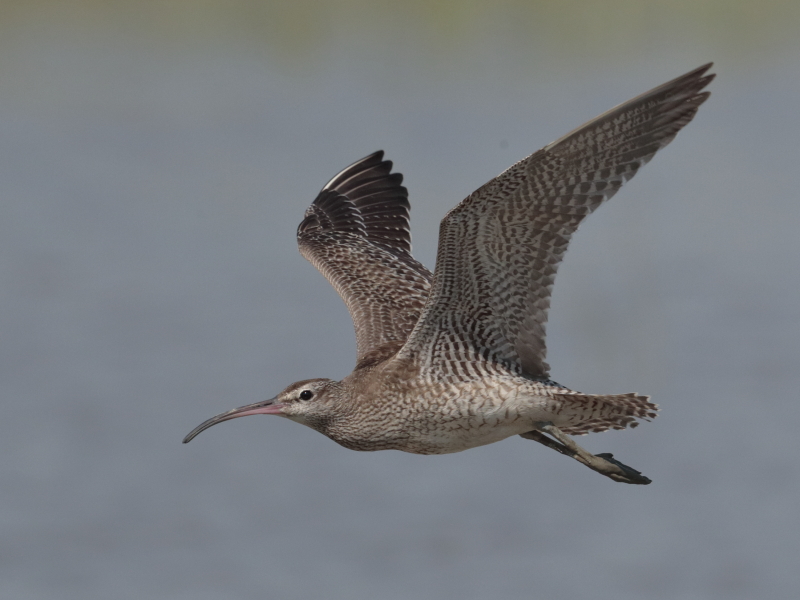Eurasian Whimbrel Numenius phaeopus 中杓鷸
Category I. Present all year, common in autumn (when most numerous) and spring migration, scarce in summer and winter. Occurs on intertidal mudflats.
IDENTIFICATION

Apr. 2020, Michelle and Peter Wong.
37-46 cm. Smaller than Eurasian Curlew with a shorter, basally thicker and blunter bill and more striking head pattern due to pale central crown stripe, contrastingly dark lateral crown stripes and dark eye stripes across entire loral area in front of the eye. Wing coverts are patterned more boldly than Eurasian Curlew.

Apr. 2020, Michelle and Peter Wong.
In flight the lower back is usually clean white or has diffuse, pale brown barring. Rarely birds with denser dark barring are seen.

Oct. 2019, John and Jemi Holmes. Juvenile.
Juveniles such as this generally have more distinct streaking on the chest than adults, clearer spotting on the upperparts and a relatively indistinct dark eye stripe behind the eye. On most birds the underwing is heavily barred; however, on a small number the underwing is noticeably paler, and the median coverts and greater secondary coverts may largely lack barring.
VOCALISATIONS
The typical flight call is a distinctive rapid succession of ringing notes.
The alarm call is similar but slight shorter and more frantic.
The song can sometimes be heard in spring.
DISTRIBUTION & HABITAT PREFERENCE
The majority of both records and highest counts are from the intertidal mudflats of Deep Bay and adjacent roosting areas, primarily Mai Po NR. However, it regularly occurs at widespread coastal sites elsewhere (e.g., Shuen Wan and on Lantau), with the highest count being 33 at Shuen Wan. It is also seen on migration over the sea, the most notable being an exceptional 320 on 25 April 2012 and 90 on 24 April 2005, both near Po Toi. It has also occurred on three occasions at Long Valley. Eurasian Whimbrel is rare on commercial fish ponds, however.
OCCURRENCE
Eurasian Whimbrel can be seen throughout the year but is most numerous on autumn passage, which largely occurs from the second week of August to the third week of September (Figure 1). Highest numbers usually occur in the second half of August, including the highest on record: 336 on 26 August 2018.
Birds remain obvious through much of October but by mid-November any birds present are likely to be wintering individuals. By far the highest midwinter numbers occurred in 2017-18, with the peak count being 151 on 18 February 2018; the next highest is 31 during winter 2008-09. Until winter 2006-07 generally only one or two birds were recorded midwinter, but it appears that milder winters arising from global heating may be allowing more to remain at this time: counts of eight or more have occurred in most winter periods since 2010.
Spring migrants are generally noted from mid-March. Most birds pass during the second half of April and the first week of May. Aside from the count of 320 on migration over the sea mentioned above, the highest spring count is 131 on 24 April 2003. Figure 2 illustrates peak spring and autumn counts made during shorebird surveys during 1998-2020. Usually, 20-30 over-summering birds are noted in most years, with the highest number being 76 on 3 July 2020. In addition, a count of 81 was made on 3 June 2021.
Vaughan and Jones (1913) stated that Whimbrel occurred from 4 September to 20 April. Dove and Goodhart (1955) saw up to 26 Whimbrels on passage from 20 August to 13 October but had no spring records. Macfarlane and Macdonald (1966) noted extreme dates for spring migration of 6 April to 22 June and 4 August to 26 October.
One ringed at Mai Po was shot on Sakhalin Island, northeast Siberia.
BEHAVIOUR, FORAGING & DIET
An obvious bird of intertidal areas, often remaining until the incoming tide has already covered the mudflat, when small flocks fly to roosting areas in Mai Po NR. Frequently seen feeding on crabs; usually locates prey visually. Has been recorded at night on migration over Sai Kung.
RANGE & SYSTEMATICS
Breeding populations are located mainly in two areas: Iceland and northern Europe, and Alaska and northern Canada; smaller areas are scattered across Siberia as far as the Sea of Okhotsk. Wintering birds occur coastally throughout much of the area south of 40oN through the southern hemisphere (Skeel and Mallory 2020).
Five subspecies are recognised of which N. p. variegatus breeding in northeast Siberia is presumed to occur in HK. However, the north central Siberian breeding form N. p. rogachevae or N. p. alboaxillaris, which breeds from west Kazakhstan to southwest Siberia, could conceivably occur rarely.
In China according to Cheng (1987) nominate phaeopus is a migrant through Xinjiang and Tibet, while N. p. variegatus passes through northeast, east and southern parts of the country, with some birds wintering along the south coast. Liu and Chen (2020) state that the north American N. p. hudsonicus occurs rarely on the east coast.
CONSERVATION STATUS
IUCN: Least Concern. Population trend decreasing.
Figure 1.

Figure 2.

Cheng, T. H. (1987). A Synopsis of the Avifauna of China. Science Press, Beijing.
Dove, R. S. and H. J. Goodhart (1955). Field observations from the Colony of Hong Kong. Ibis 97: 311-340.
Macfarlane, A. M. and A. D. Macdonald, revised by Caunter, J. R. L. and A. M. Macfarlane (1966). An Annotated Check-list of the Birds of Hong Kong. Hong Kong Bird Watching Society, Hong Kong.
Skeel, M. A. and E. P. Mallory (2020). Whimbrel (Numenius phaeopus), version 1.0. In Birds of the World (S. M. Billerman, Editor). Cornell Lab of Ornithology, Ithaca, NY, USA. https://doi.org/10.2173/bow.whimbr.01
Vaughan, R. E. and K. H. Jones (1913). The birds of Hong Kong, Macao and the West River or Si Kiang in South-East China, with special reference to their nidification and seasonal movements. Ibis 1913: 17-76, 163-201, 351-384.
Liu, Y. and Y. H. Chen (eds) (2020). The CNG Field Guide to the Birds of China (in Chinese). Hunan Science and Technology Publication House, Changsha.

